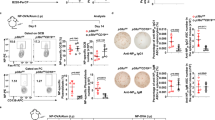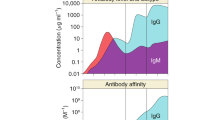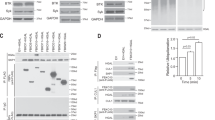Abstract
The nature of signals that govern the development of immunoglobulin heavy chain-dependent B cells is largely unknown. Using mice deficient for the B cell-expressed Src-family protein tyrosine kinases (SFKs) Blk, Fyn and Lyn, we show an essential role of these kinases in pre-B cell receptor (pre-BCR)– mediated NF-κB activation and B cell development. This signaling defect is SFK specific, as a deficiency in Syk, which controls pre-B cell development, does not affect NF-κB induction. Impaired NF-κB induction was overcome by the activation of protein kinase C (PKC)-λ, thus suggesting the involvement of PKC-λ in pre-BCR–mediated SFK-dependent activation of NF-κB. Our data show the existence of a functionally distinct SFK signaling module responsible for pre-BCR–mediated NF-κB activation and B cell development.
This is a preview of subscription content, access via your institution
Access options
Subscribe to this journal
Receive 12 print issues and online access
$209.00 per year
only $17.42 per issue
Buy this article
- Purchase on Springer Link
- Instant access to full article PDF
Prices may be subject to local taxes which are calculated during checkout






Similar content being viewed by others
References
Rajewsky, K. Clonal selection and learning in the antibody system. Nature 381, 751–758 (1996).
Karasuyama, H., Rolink, A. & Melchers, F. Surrogate light chain in B cell development. Adv. Immunol. 63, 1–41 (1996).
Reth, M. & Wienands, J. Initiation and processing of signals from the B cell antigen receptor. Annu. Rev. Immunol. 15, 453–479 (1997).
Rowley, R.B., Burkhardt, A.L., Chao, H.G., Matsueda, G.R. & Bolen, J.B. Syk protein-tyrosine kinase is regulated by tyrosine-phosphorylated Iga/Igb immunoreceptor tyrosine activation motif binding and autophosphorylation. J. Biol. Chem. 270, 11590–11594 (1995).
Takata, M. et al. Tyrosine kinases Lyn and Syk regulate B cell receptor-coupled Ca2+ mobilization through distinct pathways. EMBO J. 13, 1341–1349 (1994).
Torres, R.M., Flaswinkel, H., Reth, M. & Rajewsky, K. Aberrant B cell development and immune response in mice with a compromised BCR complex. Science 272, 1802–1804 (1996).
Turner, M. et al. Perinatal lethality and blocked B-cell development in mice lacking the tyrosine kinase Syk. Nature 378, 298–302 (1995).
Cheng, A.M. et al. Syk tyrosine kinase required for mouse viability and B-cell development. Nature 378, 303–306 (1995).
Yamanashi, Y. et al. Selective expression of a protein-tyrosine kinase, p56lyn, in hematopoietic cells and association with production of human T-cell lymphotropic virus type I. Proc. Natl. Acad. Sci. USA 86, 6538–6542 (1989).
Law, D.A., Gold, M.R. & DeFranco, A.L. Examination of B lymphoid cell lines for membrane immunoglobulin-stimulated tyrosine phosphorylation and src-family tyrosine kinase mRNA expression. Mol. Immunol. 29, 917–926 (1992).
Wechsler, R.J. & Monroe, J.G. Immature B lymphocytes are deficient in expression of the src-family kinases p59fyn and p55fgr1. J. Immunol. 154, 1919–1929 (1995).
Brouns, G.S. et al. The structure of the mu/pseudo light chain complex on human pre-B cells is consistent with a function in signal transduction. Eur. J. Immunol. 23, 1088–1097 (1993).
Spanopoulou, E. et al. Functional immunoglobulin transgenes guide ordered B-cell differentiation in Rag-1-deficient mice. Genes Dev. 8, 1030–1042 (1994).
Johnson, S.A. et al. Phosphorylated immunoreceptor signaling motifs (ITAMs) exhibit unique abilities to bind and activate Lyn and Syk tyrosine kinases. J. Immunol. 155, 4596–4603 (1995).
Zoller, K.E., MacNeil, I.A. & Brugge, J.S. Protein tyrosine kinases Syk and ZAP-70 display distinct requirements for Src family kinases in immune response receptor signal transduction. J. Immunol. 158, 1650–1659 (1997).
Texido, G. et al. The B-cell-specific Src-family kinase Blk is dispensable for B-cell development and activation. Mol. Cell. Biol. 20, 1227–1233 (2000).
Hibbs, M.L. et al. Multiple defects in the immune system of Lyn-deficient mice, culminating in autoimmune disease. Cell 83, 301–311 (1995).
Nishizumi, H. et al. Impaired proliferation of peripheral B cells and indication of autoimmune disease in lyn-deficient mice. Immunity 3, 549–560 (1995).
Stein, P.L., Lee, H.M., Rich, S. & Soriano, P. pp59fyn mutant mice display differential signaling in thymocytes and peripheral T cells. Cell 70, 741–750 (1992).
Lowell, C.A., Soriano, P. & Varmus, H.E. Functional overlap in the src gene family: inactivation of hck and fgr impairs natural immunity. Genes Dev. 8, 387–398 (1994).
Yasue, T. et al. A critical role of Lyn and Fyn for B cell responses to CD38 ligation and interleukin 5. Proc. Natl. Acad. Sci. USA 94, 10307–10312 (1997).
Horikawa, K. et al. Distinctive roles of Fyn and Lyn in IgD- and IgM-mediated signaling. Int. Immunol. 11, 1441–1449 (1999).
Meng, F. & Lowell, C.A. Lipopolysaccharide (LPS)-induced macrophage activation and signal transduction in the absence of Src-family kinases Hck, Fgr, and Lyn. J. Exp. Med. 185, 1661–1670 (1997).
Nagata, K. et al. The Iga/Igb heterodimer on m-negative proB cells is competent for transducing signals to induce early B cell differentiation. Immunity 7, 559–570 (1997).
Maki, K., Nagata, K., Kitamura, F., Takemori, T. & Karasuyama, H. Immunoglobulin b signaling regulates locus accessibility for ordered immunoglobulin gene rearrangements. J. Exp. Med. 191, 1333–1340 (2000).
Gu, H., Zou, Y.R. & Rajewsky, K. Independent control of immunoglobulin switch recombination at individual switch regions evidenced through Cre-loxP-mediated gene targeting. Cell 73, 1155–1164 (1993).
Zhang, J., Billingsley, M.L., Kincaid, R.L. & Siraganian, R.P. Phosphorylation of Syk activation loop tyrosines is essential for Syk function. An in vivo study using a specific anti-Syk activation loop phosphotyrosine antibody. J. Biol. Chem. 275, 35442–35447 (2000).
Fujimoto, M. et al. CD19 regulates Src family protein tyrosine kinase activation in B lymphocytes through processive amplification. Immunity 13, 47–57 (2000).
Li, Q. & Verma, I.M. NF-κB regulation in the immune system. Nat. Rev. Immunol. 2, 725–734 (2002).
Israel, A. The IKK complex: an integrator of all signals that activate NF-κB? Trends Cell Biol. 10, 129–133 (2000).
Karin, M. & Ben-Neriah, Y. Phosphorylation meets ubiquitination: the control of NF-κB activity. Annu. Rev. Immunol. 18, 621–663 (2000).
Delhase, M., Hayakawa, M., Chen, Y. & Karin, M. Positive and negative regulation of IκB kinase activity through IKKβ subunit phosphorylation. Science 284, 309–313 (1999).
Schwenk, F., Baron, U. & Rajewsky, K. A cre-transgenic mouse strain for the ubiquitous deletion of loxP-flanked gene segments including deletion in germ cells. Nucleic Acids Res. 23, 5080–5081 (1995).
Saijo, K. et al. Protein kinase C β controls nuclear factor κB activation in B cells through selective regulation of the IκB kinase α. J. Exp. Med. 195, 1647–1652 (2002).
Leitges, M. et al. Immunodeficiency in protein kinase Cβ-deficient mice. Science 273, 788–791 (1996).
Mischak, H. et al. Expression of protein kinase C genes in hemopoietic cells is cell-type- and B cell-differentiation stage specific. J. Immunol. 147, 3981–3987 (1991).
Valverde, A.M., Sinnett-Smith, J., Van Lint, J. & Rozengurt, E. Molecular cloning and characterization of protein kinase D: a target for diacylglycerol and phorbol esters with a distinctive catalytic domain. Proc. Natl. Acad. Sci. USA 91, 8572–8576 (1994).
Johannes, F.J., Prestle, J., Eis, S., Oberhagemann, P. & Pfizenmaier, K. PKCm is a novel, atypical member of the protein kinase C family. J. Biol. Chem. 269, 6140–6148 (1994).
Wooten, M.W., Vandenplas, M.L., Seibenhener, M.L., Geetha, T. & Diaz-Meco, M.T. Nerve growth factor stimulates multisite tyrosine phosphorylation and activation of the atypical protein kinase C's via a src kinase pathway. Mol. Cell. Biol. 21, 8414–8427 (2001).
Martin, P. et al. Role of ζ PKC in B-cell signaling and function. EMBO J. 21, 4049–4057 (2002).
Lu, Y., Jamieson, L., Brasier, A.R. & Fields, A.P. NF-κB/RelA transactivation is required for atypical protein kinase C ι-mediated cell survival. Oncogene 20, 4777–4792 (2001).
Kistler, B., Rolink, A., Marienfeld, R., Neumann, M. & Wirth, T. Induction of nuclear factor-κB during primary B cell differentiation. J. Immunol. 160, 2308–2317 (1998).
Horwitz, B.H., Scott, M.L., Cherry, S.R., Bronson, R.T. & Baltimore, D. Failure of lymphopoiesis after adoptive transfer of NF-κB-deficient fetal liver cells. Immunity 6, 765–772 (1997).
Weih, F. et al. p50-NF-κB complexes partially compensate for the absence of RelB: severely increased pathology in p50(−/−)relB(−/−) double-knockout mice. J. Exp. Med. 185, 1359–1370 (1997).
Lallena, M.J., Diaz-Meco, M.T., Bren, G., Paya, C.V. & Moscat, J. Activation of IκB kinase β by protein kinase C isoforms. Mol. Cell. Biol. 19, 2180–2188 (1999).
Yaffe, M.B. et al. A motif-based profile scanning approach for genome-wide prediction of signaling pathways. Nat. Biotechnol. 19, 348–353 (2001).
Gaide, O. et al. CARMA1 is a critical lipid raft-associated regulator of TCR-induced NF-κB activation. Nat. Immunol. 3, 836–843 (2002).
Wang, D. et al. A requirement for CARMA1 in TCR-induced NF-κB activation. Nat. Immunol. 3, 830–835 (2002).
Rolli, V. et al. Amplification of B cell antigen receptor signaling by a Syk/ITAM positive feedback loop. Mol. Cell 10, 1057–1069 (2002).
Acknowledgements
We thank M.C. Nussenzweig, K. Rajewsky and S. Desiderio for helpful discussions, M. Clark for reagents and Y. Yang for help with statistical analysis. This work is supported by grants from the National Institutes of Health (AI053545-01 to A.T. and DK58066 and HL54476 to C.A.L), the S.L.E. Foundation (to K.S.), the Irene Diamond foundation (to A.T.), the Boehringer Ingelheim Fonds (to A.P.), the Japanese Ministry of Education, Culture, Sports, Science and Technology (Grant-in-aid to H.K.), and the Deutsche Forschungsgemeinschaft (to M.R.).
Author information
Authors and Affiliations
Corresponding authors
Ethics declarations
Competing interests
The authors declare no competing financial interests.
Supplementary information
Rights and permissions
About this article
Cite this article
Saijo, K., Schmedt, C., Su, Ih. et al. Essential role of Src-family protein tyrosine kinases in NF-κB activation during B cell development. Nat Immunol 4, 274–279 (2003). https://doi.org/10.1038/ni893
Received:
Accepted:
Published:
Issue Date:
DOI: https://doi.org/10.1038/ni893
This article is cited by
-
Dasatinib overcomes glucocorticoid resistance in B-cell acute lymphoblastic leukemia
Nature Communications (2023)
-
T-independent B-cell effect of agents associated with swine grower-finisher diarrhea
Veterinary Research Communications (2023)
-
Sorafenib inhibits LPS-induced inflammation by regulating Lyn-MAPK-NF-kB/AP-1 pathway and TLR4 expression
Cell Death Discovery (2022)
-
Ets-2 deletion in myeloid cells attenuates IL-1α-mediated inflammatory disease caused by a Ptpn6 point mutation
Cellular & Molecular Immunology (2021)
-
Transitional B cells involved in autoimmunity and their impact on neuroimmunological diseases
Journal of Translational Medicine (2020)



